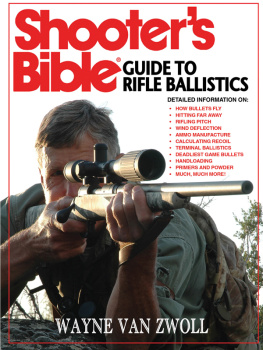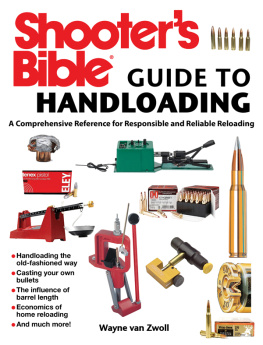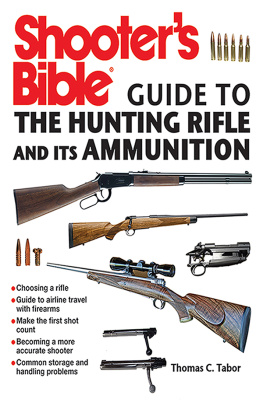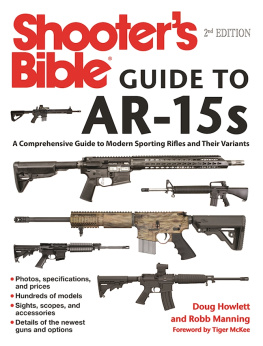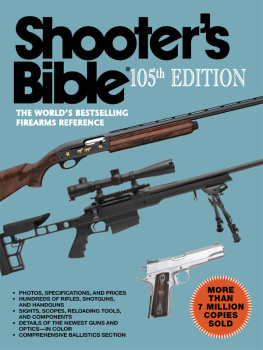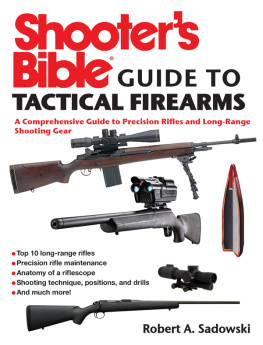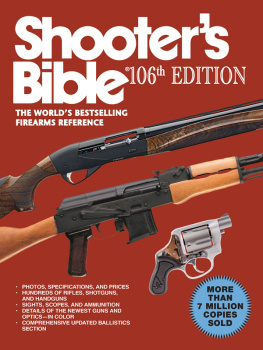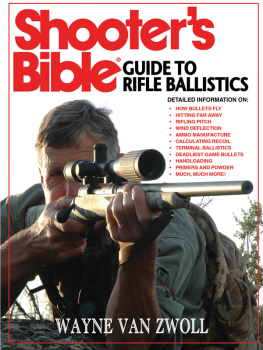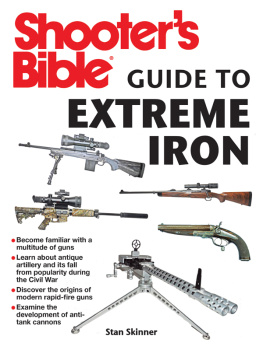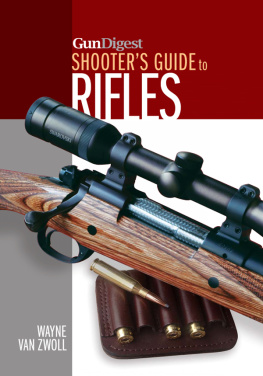T o Alice, for her efforts on the computer, for her patient, forgiving spirit, and for those miserable hours when shed rather have done just about anything than photograph a harried gun scribe with a rifle telling her exactly how to photograph a harried gun scribe with a rifle.
Copyright 2011 by Wayne van Zwoll
All Rights Reserved. No part of this book may be reproduced in any manner without the express written consent of the publisher, except in the case of brief excerpts in critical reviews or articles. All inquiries should be addressed to Skyhorse Publishing, 307 West 36th Street, 11th Floor, New York, NY 10018.
Skyhorse Publishing books may be purchased in bulk at special discounts for sales promotion, corporate gifts, fund-raising, or educational purposes. Special editions can also be created to specifications. For details, contact the Special Sales Department, Skyhorse Publishing, 307 West 36th Street, 11th Floor, New York, NY 10018 or .
Skyhorse and Skyhorse Publishing are registered trademarks of Skyhorse Publishing, Inc., a Delaware corporation.
www.skyhorsepublishing.com
10 9 8 7 6 5 4 3 2 1
Library of Congress Cataloging-in-Publication Data on file.
ISBN: 978-1-61608-224-6
Printed in China
ACKNOWLEDGMENTS
F ew worthwhile books come from one mind. This book builds on many. It also owes much to individuals not published. Some of the shooters and hunters who mentored me are no longer here. Some worked for companies like Speer and Sierra, Remington and Winchester, H-S Precision and McMillanas have many friends and colleagues still able to critique this book. J.B. Hodgdon always answered my questions. So did Hornadys ballistics wizard Dave Emary, and Larry Werner, with his rich knowledge of DuPont and its products. Lee Reed, who started Swift Bullets, with Randy Brooks at Barnes and a host of knowledgeable riflemen at other bullet and ammunition firms contributed. Art Alphin, a standout in an industry of colorful men, added information on interior ballistics. Star competitive shooters Lones Wigger and Gary Anderson told me how to better direct bullets. Darrell Holland has reminded me. So, still, does friend Rich McClure, a softspoken rifle enthusiast whose long shooting career has garnered a wall of medals. Dr. Ken Oehler taught me a great deal about ballistics and tutored me on his superb chronographs. John Burns showed me how precise shooting with deadcenter holds is possible to distances of over a mile. Ive learned much from rifle- and barrel-makers too. Talented craftsmen like DArcy Echols and Gary Goudy have shown me how rifles are built from scratch. John Krieger has helped me understand how a bullet gets its best start. The list of contributors is really too long for this page. Ill truncate it here with a salute to Earl Wickman, who years ago in his basement range in central Michigan, coached an awkward young shooter with a DCM .22.
Wayne van Zwoll
FOREWORD
T his book is for hunters and shooters keen to know more about the behavior of bullets in flight. Until you know what affects a bullet, after all, you cant control its path. A bullet is moving so fast that air cant easily get out of its way. Air imposes tremendous pressure against the bullets nose and shank, and a vacuum behind the heel. Pressure results in drag, which can amount to many times the force of gravity. As drag overcomes inertia, the bullet slows down. Meanwhile, gravity pushes it to earth. The slower the bullet goes, the more time gravity has to work on it, and the steeper its arc. Thats why a bullet scribes a parabolic course, not one shaped like a rainbow. Wind puts on bends that curve right or left.
Here youll learn not only why bullets behave like they do but how to aim so they go where you want them to. Youll shoot better at long range, in wind, up and down hills and at moving targets. Youll find out what makes some rifles kick harder than others and some loads shoot more accurately than others. Youll get a short course on miragewhat causes it, how to read it, and why bullets riding three oclock mirage may also rise, while mirage from the left commonly depresses the shot. Youll get straight talk on bullet deflection in brush, and the ballistic effects of temperature and elevation.
Terminal bullet performance matters to hunters, often even more so than accuracy and flat flight. This book sifts out the best loads for big game and examines the trend toward leadfree bullets. It tells how bullets are made and compares the most popular. Theres also a concise treatise on powder manufacture. If youre a handloader, youll appreciate knowing how the most popular propellants came to be, and how to choose among them. The chapter on handloading technique is your step-by-step guide to more effective ammunition.
After four decades studying ballistics then testing what I learned on the range and in the field, Im still a student. Fortunately, you dont need a graduate degree in physics to understand exterior ballistics or to accurately direct a bullet. Id like to say all you need is this book. In truth, you need trigger time, too.
Wayne van Zwoll
INTRODUCTION
S ure, theres math. But ballistics is also intuitive. Its how we describe things hurtling through air.
A basketball at rest in a corner of the gym is a lot like a bullet in the chamber of a rifle. Neither is very interesting, because neither is moving. Put the basketball in play or fire the rifle, and you set in motion a raft of variables that comprise the study of ballistics. Acceleration, deceleration, velocity, mass, energy, inertia, drag, profile, sectional density and the tug of gravityto name just a fewaffect the paths of all objects hurled through our atmosphere, from rocks to rockets. The name ballistic missile is oddly redundant, because every missile becomes ballistic at launch. Every projectile has ballistic properties.
In this book, ballistics has to do with bullet behavior. Once it leaves the muzzle, a bullet has only momentum to carry it (unlike a guided missile, which gets both power and direction during flight). A firm grasp of ballistics is a first step toward more effective shooting. Ballistics is really a three part discipline. Interior ballistics describes the turbulence inside a rifle: primer ignition, gas production and pressure, bullet release and acceleration. Exterior ballistics has to do with bullet flightvelocity, energy and trajectory as the bullet moves from muzzle to target. Terminal ballistics comes in after the strike; most commonly its a measure of bullet penetration and upset in a game animal or an adversary.
Interior ballistics is mostly a laboratory science. Sophisticated instruments measure high pressures over tiny slices of time. Charting pressure curves, ballisticians assess performance and design propellants and bullets for commercial loads. Though it represents a small fraction of the eyeblink delay between striker fall and the bullets impact 100 yards away, the launch has a profound effect on bullet trajectory and accuracy. Few shooters, though, are equipped to measure interior ballistics or manipulate them based on what happens before bullet exit. Riflemen have a much easier task with exterior ballistics. You can clock a bullet with a chronograph to determine its velocity. Plugging bullet speed and weight into a formula yields a measure of its energy. Drop and drift are a snap to determinesimply measure displacement at the target. By changing loads, you affect both interior and exterior ballistics, except for pressure signs on cartridge cases, meaningful measures of bullet performance all come forward of the muzzle.
Bullet velocity, energy, and trajectory have become standard items in ballistics charts provided by makers of ammunition and ammunition components. The properties of bullets in flight are relatively easy to quantify, very easy to compare in charts. With them, you can assess the practical reach of your rifle (as regards killing power, not accuracy) and its most efficient zero range.
Next page
